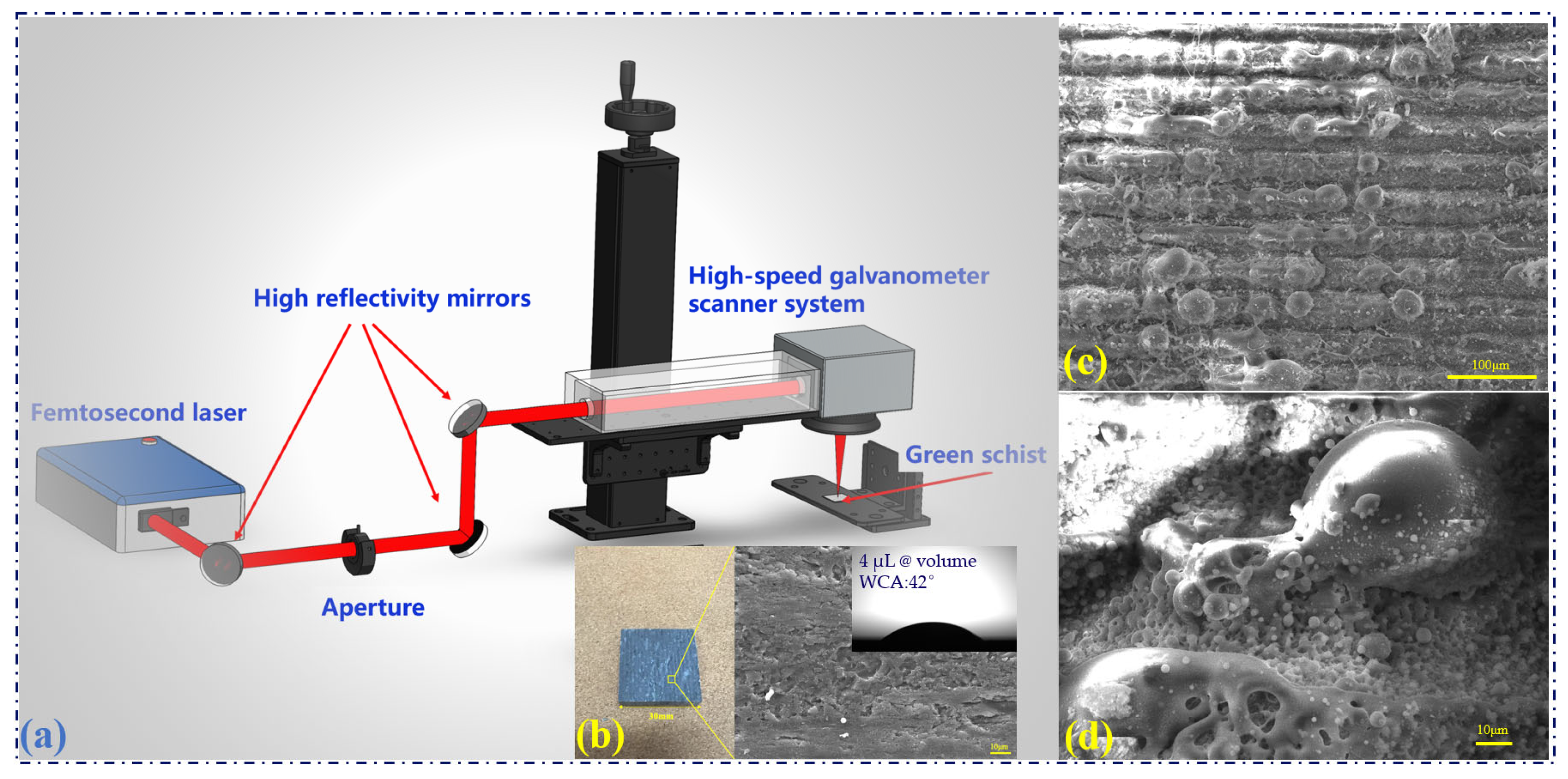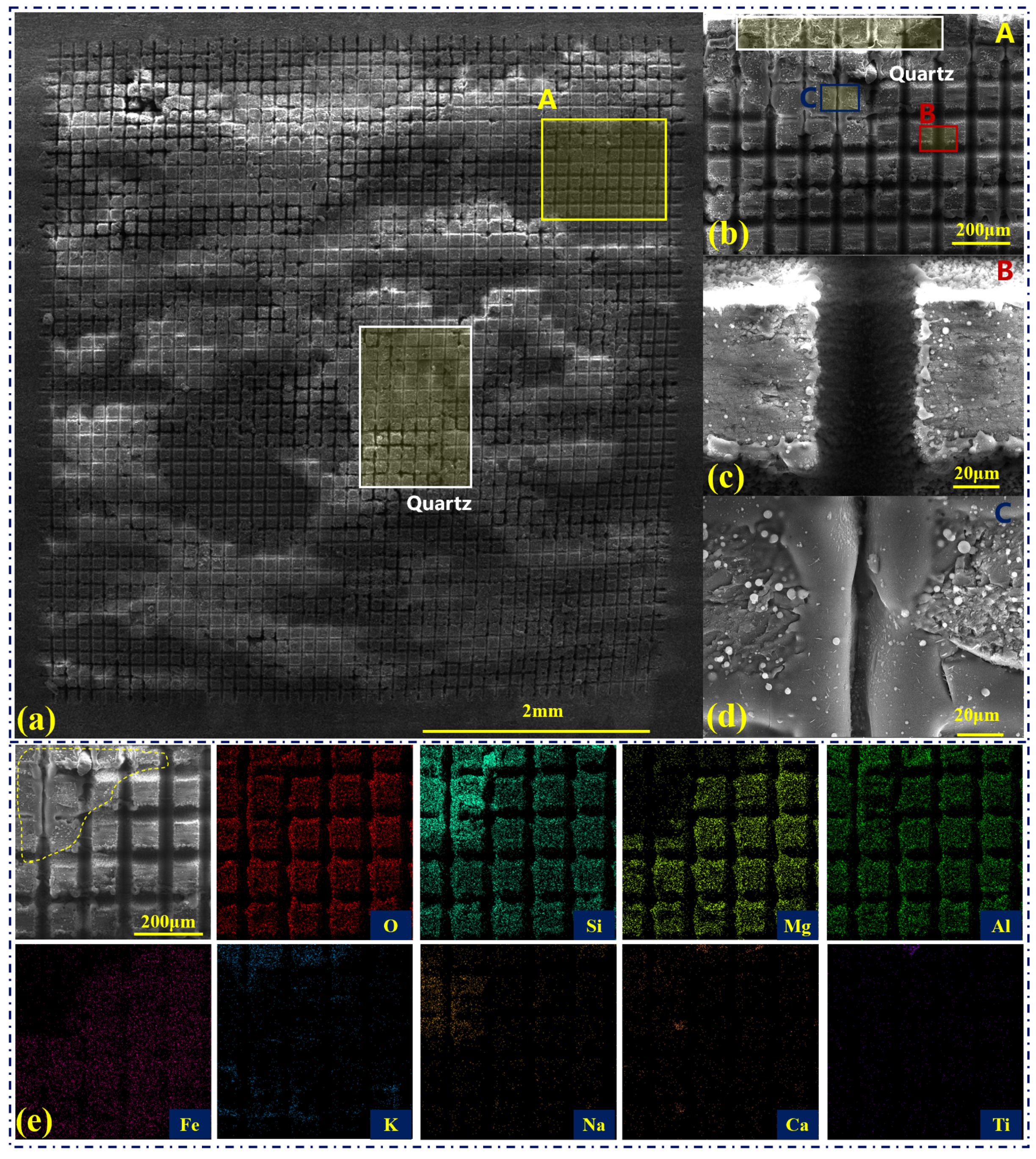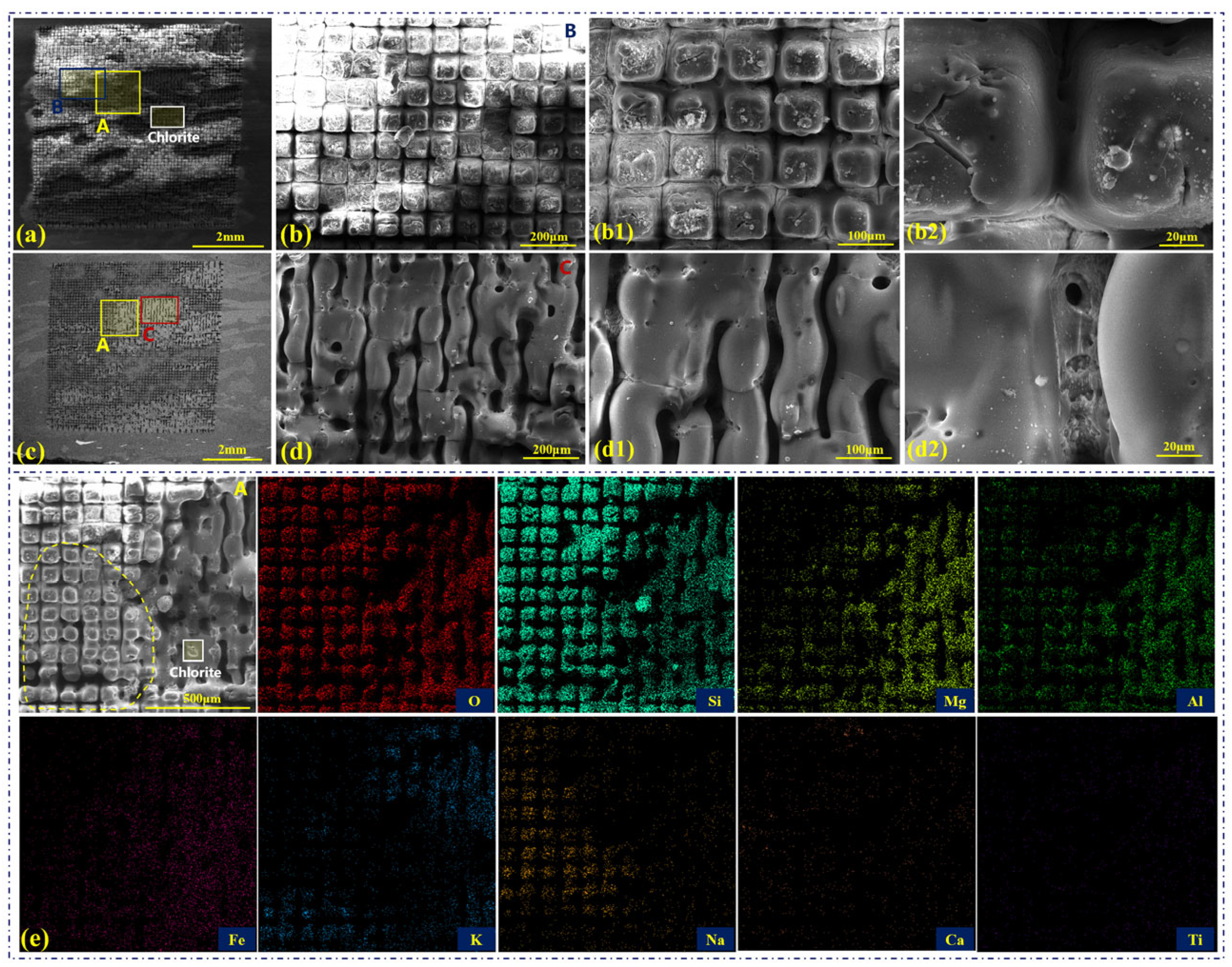Application of Femtosecond Laser Processing Method in the Sustainable Conservation of Stone Cultural Relics: An Example of Green Schist in Wudang Mountain, China
Abstract
:1. Introduction
2. Materials and Methods
2.1. Materials
2.2. Experimental Setup
2.3. Instruments and Characterization
3. Results and Discussion
3.1. The Ablation Performance of Femtosecond Laser to Green Schist
3.2. The Grooving Performance of Femtosecond Laser to Green Schist
3.3. Characterization of Surface Wettability after the Femtosecond Laser Grooving
4. Conclusions
- (1)
- The three compositions of green schist, quartz, chlorite, and muscovite show multiple types of performances under irradiation of the femtosecond laser. The nonlinear absorption of the femtosecond laser by the quartz composition reflects the cold ablation performance. The linear absorption of the chlorite composition reflects cold ablation (500 pulses) and melting (5000 pulses). The muscovite composition reflects typical thermal heating, melting, expansion, and ablation.
- (2)
- Due to the differences between the multiple compositions of green schist, the femtosecond laser single-point ablation does not result in the formation of a regular micro-nano structure on the sample surface. However, the scanning of the femtosecond laser can reduce the effect of compositional differences in the laser ablation performance, providing the possibility of high-performance laser processing of non-homogeneous material.
- (3)
- The multiple scanning of the femtosecond laser reduces the thermal effect of the femtosecond laser on the green schist and is thus suitable for the preparation of structures with varying groove spacing. In particular, the sample surface processed at a groove spacing of 400 μm obtains a high contact angle (147°), which is related to the formation of hierarchical micro-nano structures by the ablation of the femtosecond laser.
Author Contributions
Funding
Institutional Review Board Statement
Informed Consent Statement
Data Availability Statement
Acknowledgments
Conflicts of Interest
References
- Lei, Z.; Wan, L.; Zhang, Y. Investigation, Diagnosis, Assessment and Conservation Strategy for a Wall Painting at Wudang Mountain Taoist Temple Using BIM Technology. Stud. Conserv. 2018, 63 (Suppl. S1), 377–380. [Google Scholar] [CrossRef]
- Xu, W. Wild Edible Plants and Pilgrimage on Wudang Mountain. J. Ethnobiol. 2015, 35, 606–627. [Google Scholar]
- Wang, C.; Chen, M.; Wang, Y. Surface flaking mechanism of stone components of ancient building complex in Wudang Mountain, China. Constr. Build. Mater. 2023, 399, 132611. [Google Scholar] [CrossRef]
- Sadat-Shojai, M.; Ershad-Langroudi, A. Polymeric coatings for protection of historic monuments: Opportunities and challenges. J. Appl. Polym. Sci. 2010, 112, 2535–2551. [Google Scholar] [CrossRef]
- Nosonovsky, M.; Bhushan, B. Biologically inspired surfaces: Broadening the scope of roughness. Adv. Funct. Mater. 2008, 18, 843–855. [Google Scholar] [CrossRef]
- Weng, W.; Deng, Q.; Yang, P.; Yin, K. Femtosecond laser-chemical hybrid processing for achieving substrate-independent superhydrophobic surfaces. J. Cent. South Univ. 2024, 31, 1–10. [Google Scholar] [CrossRef]
- Darmanin, T.; Guittard, F. Superhydrophobic and superoleophobic properties in nature. Mater. Today 2015, 18, 273–285. [Google Scholar] [CrossRef]
- Lin, F.; Shuhong, L.; Yingshun, L.; Huanjun, L.; Lingjuan, Z.; Jin, Z.; Yanlin, S.; Biqian, L.; Lei, J.; Daoben, Z. Super-hydrophobic Surfaces: From Natural to Artificial. Adv. Mater. 2003, 14, 1857–1860. [Google Scholar]
- Revez, M.J.; Raposo, M.; Rodrigues, J.D. The prodomea phasing and compatibility indicators as tools for the planning and design of conservation interventions. Assessment and validation in the santa clara-a-velha monastery (coimbra, portugal). In Proceedings of the International Congress on Deterioration & Conservation of Stone, New York, NY, USA, 22–26 October 2012. [Google Scholar]
- Xu, S.; Wang, Q.; Wang, N.; Qu, L.; Song, Q. Study of corrosion property and mechanical strength of eco-friendly fabricated superhydrophobic concrete. J. Clean. Prod. 2021, 323, 129267. [Google Scholar] [CrossRef]
- Wang, N.; Wang, Q.; Xu, S.; Lei, L. Green fabrication of mechanically stable superhydrophobic concrete with anti-corrosion property. J. Clean. Prod. 2021, 312, 127836. [Google Scholar] [CrossRef]
- Liu, C.; Zheng, J.; Liu, X.; Yin, K.; Wang, H.; Wang, Q. Facile laser-based process of superwetting zirconia ceramic with adjustable adhesion for self-cleaning and lossless droplet transfer. Appl. Surf. Sci. 2023, 638, 158069. [Google Scholar] [CrossRef]
- Yong, J.; Chen, F.; Li, M.; Yang, Q.; Fang, Y.; Huo, J.; Hou, X. Remarkably simple achievement of superhydrophobicity, superhydrophilicity, underwater superoleophobicity, underwater superoleophilicity, underwater superaerophobicity, and underwater superaerophilicity on femtosecond laser ablated PDMS surfaces. J. Mater. Chem. A 2017, 5, 25249–25257. [Google Scholar] [CrossRef]
- Xu, J.; Su, Q.; Shan, D.; Guo, B. Sustainable micro-manufacturing of superhydrophobic surface on ultrafine-grained pure aluminum substrate combining micro-embossing and surface modification. J. Clean. Prod. 2019, 232, 705–712. [Google Scholar] [CrossRef]
- Huang, X.; Sun, M.; Shi, X. Chemical vapor deposition of transparent superhydrophobic anti-Icing coatings with tailored polymer nanoarray architecture. Chem. Eng. J. 2023, 454, 139981. [Google Scholar] [CrossRef]
- Bai, X.; Yang, S.; Tan, C.; Jia, T.; Guo, L.; Song, W.; Jian, M.; Zhang, X.; Zhang, Z.; Wu, L.; et al. Synthesis of TiO2 based superhydrophobic coatings for efficient anti-corrosion and self-cleaning on stone building surface. J. Clean. Prod. 2022, 380, 134975. [Google Scholar] [CrossRef]
- Wang, J.; Zhang, Y.; He, Q. Durable and robust superhydrophobic fluororubber surface fabricated by template method with exceptional thermostability and mechanical stability. Sep. Purif. Technol. 2023, 306, 122423. [Google Scholar] [CrossRef]
- Eryildiz, B.; Ozbey-Unal, B.; Menceloglu, Y.Z.; Keskinler, B.; Koyuncu, I. Development of robust superhydrophobic PFA/TMI/PVDF membrane by electrospinning/electrospraying techniques for air gap membrane distillation. J. Appl. Polym. Sci. 2023, 140, 53635. [Google Scholar] [CrossRef]
- Yang, X.; Yang, N.; Gong, Z.; Peng, F.; Jiang, B.; Sun, Y.; Zhang, L. The superhydrophobic sponge decorated with Ni-Co double layered oxides with thiol modification for continuous oil/water separation. Chin. J. Chem. Eng. 2022, 54, 296–305. [Google Scholar] [CrossRef]
- Zhao, J.; Gao, X.; Chen, S.; Lin, H.; Li, Z.; Lin, X. Hydrophobic or superhydrophobic modification of cement-based materials: A systematic review. Compos. Part B Eng. 2022, 243, 110104. [Google Scholar] [CrossRef]
- Wang, C.; Ding, K.; Song, Y.; Jia, X.; Lin, N.; Duan, J.A. Femtosecond laser patterned superhydrophobic surface with anisotropic sliding for droplet manipulation. Opt. Laser Technol. 2024, 168, 109829. [Google Scholar] [CrossRef]
- Zhang, C.; Zhang, X.; Shen, H.; Shuai, D.; Xiong, X.; Wang, Y.; Huang, H.; Li, Y. Superior self-cleaning surfaces via the synergy of superhydrophobicity and photocatalytic activity: Principles, synthesis, properties, and applications. J. Clean. Prod. 2023, 428, 139430. [Google Scholar] [CrossRef]
- Schnell, G.; Polley, C.; Thomas, R.; Bartling, S.; Wagner, J.; Springer, A.; Seitz, H. How droplets move on laser-structured surfaces: Determination of droplet adhesion forces on nano- and microstructured surfaces. J. Colloid Interface Sci. 2022, 630, 951–964. [Google Scholar] [CrossRef]
- Sun, X.; Fan, K.; Wang, Z.; Mei, R.; Yang, X. Regulation of hydrophobicity on yttria stabilized zirconia surface by femtosecond laser. Ceram. Int. 2021, 47, 9264–9272. [Google Scholar] [CrossRef]
- Zhao, D.; Zhu, H.; Zhang, Z.; Xu, K.; Lei, W.; Gao, J.; Liu, Y. Transparent superhydrophobic glass prepared by laser-induced plasma-assisted ablation on the surface. J. Mater. Sci. 2022, 57, 15679–15689. [Google Scholar] [CrossRef]
- Chantada, A.; Penide, J.; Riveiro, A.; del Val, J.; Quintero, F.; Meixus, M.; Soto, R.; Lusquiños, F.; Pou, J. Increasing the hydrophobicity degree of stonework by means of laser surface texturing: An application on Zimbabwe black granites. Appl. Surf. Sci. 2017, 418, 463–471. [Google Scholar] [CrossRef]
- Carrascosa, L.A.M.; Zarzuela, R.; Botana-Galvín, M.; Botana, F.J.; Mosquera, M.J. Achieving superhydrophobic surfaces with tunable roughness on building materials via nanosecond laser texturing of silane/siloxane coatings. J. Build. Eng. 2022, 58, 104979. [Google Scholar] [CrossRef]
- Ding, Y.; Liu, L.; Wang, C.; Li, C.; Lin, N.; Niu, S.; Han, Z.; Duan, J. Bioinspired Near-Full Transmittance MgF2 Window for Infrared Detection in Extremely Complex Environments. ACS Appl. Mater. Interfaces 2023, 15, 30985–30997. [Google Scholar] [CrossRef]
- López, A.J.; Pozo-Antonio, J.S.; Moreno, A.; Rivas, T.; Pereira, D.; Ramil, A. Femtosecond laser texturing as a tool to increase the hydrophobicity of ornamental stone: The influence of lithology and texture. J. Build. Eng. 2022, 51, 104176. [Google Scholar] [CrossRef]
- López, A.J.; Ramil, A.; Pozo-Antonio, J.S.; Rivas, T.; Pereira, D. Ultrafast Laser Surface Texturing: A Sustainable Tool to Modify Wettability Properties of Marble. Sustainability 2019, 11, 4079. [Google Scholar] [CrossRef]
- Ariza, R.; Alvarez-Alegria, M.; Costas, G.; Tribaldo, L.; Gonzalez-Elipe, A.R.; Siegel, J.; Solis, J. Multiscale ultrafast laser texturing of marble for reduced surface wetting. Appl. Surf. Sci. 2022, 577, 151850. [Google Scholar] [CrossRef]
- Díaz, A.J.L.; Ramil, A.; Freire-Lista, D.M. Evaluation of femtosecond laser texturing on carbonate heritage stones. In Lasers in the Conservation of Artworks XIII; CRC Press: Boca Raton, FL, USA, 2023; pp. 234–244. [Google Scholar]
- Jia, X.; Dong, J.; Wang, H.; Aleksei, K.; Zhu, G.; Zhu, X. High-speed drilling of alumina ceramic by sub-microsecond pulsed thin disk laser. Opt. Express 2020, 28, 33044–33052. [Google Scholar] [CrossRef]
- Jia, X.; Luo, J.; Guo, C.; Li, Z.; Ma, Z.; Xiang, Y.; Yi, Z.; Li, K.; Wang, C.; Li, X.; et al. High-energy continuous wave laser ablation of alumina ceramic. J. Mater. Res. Technol. 2023, 27, 5389–5403. [Google Scholar] [CrossRef]
- Xie, X.; Zhou, C.; Wei, X.; Hu, W.; Ren, Q. Laser machining of transparent brittle materials: From machining strategies to applications. Opto-Electron. Adv. 2019, 2, 18001701–18001713. [Google Scholar] [CrossRef]
- Lin, Z.; Hong, M. Femtosecond Laser Precision Engineering: From Micron, Submicron, to Nanoscale. Ultrafast Sci. 2021, 2021, 9783514. [Google Scholar] [CrossRef]
- Tan, D.; Zhang, B.; Qiu, J. Ultrafast Laser Direct Writing in Glass: Thermal Accumulation Engineering and Applications. Laser Photonics Rev. 2021, 15, 2000455. [Google Scholar] [CrossRef]
- Pou-Álvarez, P.; Riveiro, A.; Nóvoa, X.R.; Fernández-Arias, M.; del Val, J.; Comesaña, R.; Boutinguiza, M.; Lusquiños, F.; Pou, J. Nanosecond, picosecond and femtosecond laser surface treatment of magnesium alloy: Role of pulse length. Surf. Coat. Technol. 2021, 427, 127802. [Google Scholar] [CrossRef]
- Jia, X.; Chen, Y.; Liu, L.; Wang, C.; Duan, J. Advances in Laser Drilling of Structural Ceramics. Nanomaterials 2022, 12, 230. [Google Scholar] [CrossRef]






Disclaimer/Publisher’s Note: The statements, opinions and data contained in all publications are solely those of the individual author(s) and contributor(s) and not of MDPI and/or the editor(s). MDPI and/or the editor(s) disclaim responsibility for any injury to people or property resulting from any ideas, methods, instructions or products referred to in the content. |
© 2024 by the authors. Licensee MDPI, Basel, Switzerland. This article is an open access article distributed under the terms and conditions of the Creative Commons Attribution (CC BY) license (https://creativecommons.org/licenses/by/4.0/).
Share and Cite
Chen, M.; Wang, C.; Li, K.; Jia, X.; Wang, C.; Wang, Y. Application of Femtosecond Laser Processing Method in the Sustainable Conservation of Stone Cultural Relics: An Example of Green Schist in Wudang Mountain, China. Sustainability 2024, 16, 3169. https://doi.org/10.3390/su16083169
Chen M, Wang C, Li K, Jia X, Wang C, Wang Y. Application of Femtosecond Laser Processing Method in the Sustainable Conservation of Stone Cultural Relics: An Example of Green Schist in Wudang Mountain, China. Sustainability. 2024; 16(8):3169. https://doi.org/10.3390/su16083169
Chicago/Turabian StyleChen, Mu, Chengaonan Wang, Kai Li, Xianshi Jia, Cong Wang, and Yansong Wang. 2024. "Application of Femtosecond Laser Processing Method in the Sustainable Conservation of Stone Cultural Relics: An Example of Green Schist in Wudang Mountain, China" Sustainability 16, no. 8: 3169. https://doi.org/10.3390/su16083169
APA StyleChen, M., Wang, C., Li, K., Jia, X., Wang, C., & Wang, Y. (2024). Application of Femtosecond Laser Processing Method in the Sustainable Conservation of Stone Cultural Relics: An Example of Green Schist in Wudang Mountain, China. Sustainability, 16(8), 3169. https://doi.org/10.3390/su16083169









